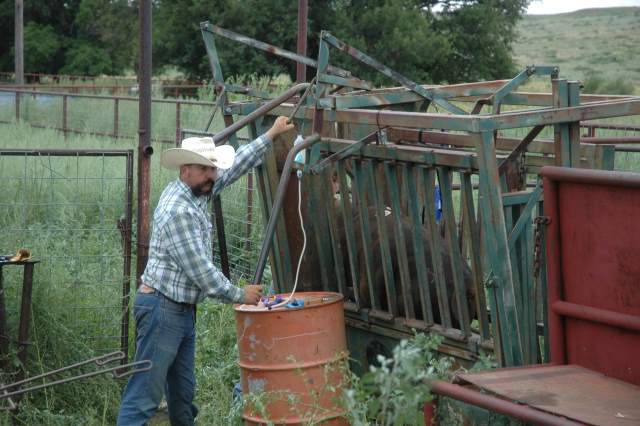November 4, 2014

Unlike the Golden Rule, you might want to call it the Rusty Nail Rule: Do unto others before they do unto you. While that’s clearly an unethical mindset to running a business, it is, unfortunately, a strong temptation when it comes to dealing with bovine viral diarrhea (BVD).
That’s because of the pervasive and often costly effects of BVD. In fact, when you talk to veterinarians about BVD, calf diarrhea is usually down on the list: It is the root cause of abortions in pregnant cows, respiratory disease in stocker and feedyard cattle, and a host of other diseases. It affects cattle producers in every segment of the business and while BVD can be a devastating disease economically, it most often works its damage insidiously, causing sub-clinical losses that can, over time, be significant.
And then there’s the issue of persistently infected (PI) calves. They look normal, act normal, indeed are normal, except that they are a never-ending reservoir for the BVD virus, leaving death and economic destruction in their wake. That’s where the Golden….uuh, Rusty Nail Rule comes into play—what to do with a PI calf.
A conundrum indeed. But first, a little background. BVD is significant enough that several industry organizations, including the American Association of Bovine Practitioners, the Academy of Veterinary Consultants and the National Cattlemen’s Beef Association have policy encouraging its control and eventual eradication.
What’s more, the U.S. cattle industry has models already in place to successfully launch an all-out attack on the virus. And, based on experiences in both the U.S. and Europe, those models work, researchers said at a recent seminar on BVD eradication. The seminar was sponsored by Thermo Fisher Scientific, Merck Animal Health and the Kansas State University (KSU) Diagnostic Laboratory.
According to John VanLeeuwen with the University of Prince Edward Island in Canada, the Norwegians initiated a BVD eradication program in 1992 that eradicated the disease from their cattle herd. Since vaccines were banned in the country at the time, the program focused on identifying and eliminating PI calves. While the 10-year program was successful, it was heavy-handed—all cattle had to be tested; if a PI was found, it was culled and the farm was quarantined until the tests were negative.
Ireland has recently embarked on a similar eradication program, VanLeeuwen says, which also is based on eliminating PIs from the national herd. It’s a six-year program that tests all newborn calves and recommends, but doesn’t force producers to cull PIs. While a voluntary program will take longer and can be argued to be less effective, VanLeeuwen predicts the Irish will eventually be successful.
Here in the U.S., an effort in Michigan’s Upper Peninsula that kicked off in 2007 proved that BVD can certainly be controlled, if not eliminated. According to Dan Grooms with Michigan State University, the voluntary program focused first on education, then on testing for and eliminating PIs, plus adopting sufficient biosecurity efforts to keep the disease from moving from farm to farm and a comprehensive vaccination program.
While the program showed it is possible to significantly control BVD, Grooms says the biggest benefit was the effect it had on total herd health. “Even though the BVD eradication program doesn’t exist up there today, those guys are still thinking about biosecurity; they’re still thinking about good, sound vaccination programs; and they’re a lot farther ahead in controlling all pathogens, let alone BVD,” Grooms says.
Then, there’s the model from the effort in the U.S. to eradicate brucellosis and tuberculosis, says Dan Thomson, head of KSU’s Beef Cattle Institute. Perhaps the best lesson the industry can take from those efforts is that if you’re going to mount a battle against a disease, you have to be strategic, he says.
“If we want to do it, we’ve got to do it right,” he says. “We’ve got to have a plan.”
In his mind, that plan needs several key elements—it has to have a testing component coupled with an identification and traceability system so the industry can identify, track and remove PI cattle from the marketing mix; it has to have a vaccination component; and it has to have a biosecurity component. But most of all, it has to have an indemnity program to encourage producers to remove, permanently, PI cattle from the mix.
Enter the Rusty Nail Rule. Say a producer experiences a higher-than-normal abortion loss. After a little diagnostics, BVD is the problem and the testing reveals a couple of PI calves. Since BVD isn’t transferrable to humans, the best thing to do take the calves to a locker plant and put them in your freezer. But with the price of calves, the tempting thing to do is take them to town and let someone else deal with them.
It doesn’t take too many swings of the hammer before a rusty nail breaks off short. And when it does, it’s possible that the walls can come tumbling down.
So it’s not a question of whether or not we can eradicate BVD. The question is should we? Thomson, who believes BVD is a serious-enough threat to warrant eradication, thinks that’s a viable option, if we go at it strategically.
Van Leeuwen agrees. “Bottom line, it’s out there,” he says. “We know it’s costing a lot of money and costing animals lots of pain and suffering. Some countries have already gone down the road to start to control it and some regions have eradicated it. We have the tools; do we have the funds and the willpower?”
Other trending BEEF articles:
Should You Be Worried About Cattle Ingesting Net Wrap?
3 Steps To Negotiating A Great Cow Lease
NEW PHOTO GALLERY: Home Is Where You Hang Your Hat
The Importance Of Beef Reproduction: What How Why
10 Utility Tractors For 2014 That Offer More Power & Comfort
Why Freeze Branding Is ID Of Choice For Many Commercial Ranches
You May Also Like



